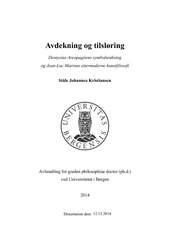| dc.description.abstract | This study addresses the relation between the sixth century Christian author, Dionysius the Areopagite, and the French postmodern philosopher, Jean-Luc Marion (1946- ). The importance of the Dionysian writings (Corpus Areopagiticum) for Marion’s development of a new phenomenology of «saturation» and «givenness» is well known. Still the Dionysian key tone of his philosophy of art in The Crossing of the Visible is largely overlooked by scholars. This dissertation tries to demonstrate that the influence from Dionysius in this work is profound, most importantly in Marion’s thought on the appearance of the invisible in icons and other paintings, interpreted as an interplay between disclosure and concealment. The dissertation should be read as a study in the history of aesthetic ideas, as it traces the development of certain concepts from antiquity to postmodernity. The main «objects» of this study – Corpus Areopagiticum and The Crossing of the Visible – also require an interdisciplinary approach between philosophy, art history and theology. Basically Marion transfers the Dionysian theology of how to approach God as «the wholly Other» to his own philosophy on the recognition of otherness or invisibility in images. The first part of the study offers a survey of the symbolical theology of Dionysius the Areopagite, as a background for the recognition of his influence on Marion in part 2. The main thesis in part 1 suggests that Dionysius’ symbolism is based on a «fundamentally apophatic attitude», and that his thought on symbols should be seen as an aesthetic equivalent to his apophatic philosophy of language. Chapter 2 presents the theological vision of Corpus Areopagiticum as the context of Dionysius’ theological symbolism. Chapter 3 and 4 interprets Dionysius’ symbolical thought in relation to his Neo-Platonic and Christian predecessors. The characteristic quality of symbols according to Dionysius is that they reveal divine otherness without objectifying God. Here his concept of similarity and dissimilarity is crucial. For symbols reveal divine otherness by being simultaneously like and unlike the transcendent God. Dionysius understands this as a simultaneous disclosure–concealment, and finds this symbolism both in the visualizing language of Scripture as well as in the dramaturgy of the holy liturgy. Chapter 5 and 6 develop the perspective of revelation as symbolic in Dionysius’ thought. They demonstrate how Dionysius radicalizes the tradition of apophatic theology, in his philosophy of language, but also in his understanding of symbols as sensual signs of ineffable realities. His concepts of «similar and dissimilar symbols» give us the key to understanding symbolism as an aesthetic version of apophatic theology, where seeing is regarded as the primary human sense. Accordingly Dionysius understands symbols as intermediaries between the invisible and the visible. Chapter 8 offers an introduction to Marion’s post-metaphysical thinking, focusing on the ideas that are most fundamental for his philosophy of art, namely his rethinking of the relation between the subject and phenomena that exceed our daily life experience. Marion holds that the human subject is not a producer but a receiver of meaning. He sees human understanding in terms of «receiving a gift». Chapter 9 analyses Marion’s reception of Corpus Areopagiticum in his earlier writings. These books give a preview of his later thoughts on icons and paintings as «saturated phenomena». Chapter 10 offers a successive interpretation of The Crossing of the Visible, where we find Marion’s philosophy of the gaze, and of seeing as receiving «what gives itself to be seen». This chapter demonstrates how Marion draws on Dionysius’ symbolical thought in his philosophy of images as «non-objects», and his fundamental idea of «going beyond the first visible». | en_US |
